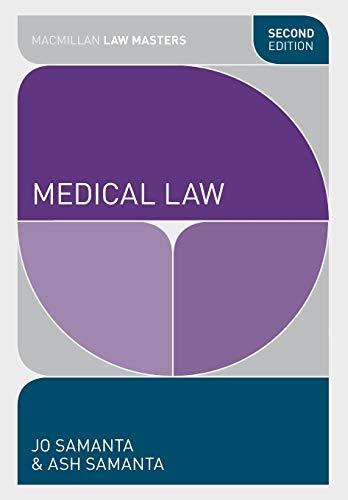Question
1. Law actually refers to the duties imposed upon people requiring them to act in a certain manner. True or False 2. Society refers to
1. Law actually refers to the duties imposed upon people requiring them to act in a certain manner.
True or False
2. "Society" refers to a group of people, large or small.
True or False
3. The right of free speech is guaranteed by the Constitution.
True or False
4. A government may take private property without compensation if it is needed for public use.
T or F
5. "Law" refers only to statutes passed by federal and state legislatures.
T or F
6. Any law, whether enacted by congress or by a state legislature, may be declared invalidif it conflicts with the Constitution of the United States.
T or F
7. Legal action is not generally taken against a person who does something that is only ethically wrong.
T or F
8. At least four out of nine justices must agree to hear an appeal from a state or federal court before a case comes before the U.S. Supreme Court.
T or F
9. The U.S. system of government is based on a concept known as separation of powers.
T or f
10. Both statute law and case law are used in the United States legal system to reach decisionsin civil and criminal law suits.
T or F
11. The United States has two separate and distinct court systems: the federal court system and the state court system.
T or F
12. The federal court system varies from one area of the country to another.
T or F
13.A major reason for findingalternatives to a lawsuitis that the person you are thinking of suing may be judgment proof.
T or F
14. Once a party to a lawsuit "wins" the case, the "winning" party will have very little difficulty on collecting the amount of damagesawarded by the jury.
T or F
15. If you are declared the winner in a lawsuit, yuou most likely will be awarded money damages.
T or F
16.The plaintiff in a civil action is the state or federal governmentacting for the person bringing the lawsuit.
T or F
17.An application to a judge for a ruling on a point of law is called a motion.
T or F
18.A major reason rules or laws were first established was to:
a. provide jobs for people
b. restrict people's movement in society
c. make it possible for the majority to rule the rest
d. protect the rights of individuals against the acts of others
19. The Social Security system is an exampleof using law to
a. protect individuals
b. promote worthwhile social objectives
c. protect property
d. protect society
20. Law in the United States is derived from
a. constitutions, statutes and ordinances
b. case law
c. administrative regulations
d. all of these
21. The practice of following precedents in deciding later cases is known as
a. stare decisis
b. equity
c. statute law
d. moral law
22. The plaintiff in a civil lawsuit is the
a. state
b. attorney fir the person injured
c. person injured
d. person being sued.
23.Merchants are very cautious about accusing and holding people for shoplifting
because they may be sued for
a. assault
b. battery
c. false imprisonment
d. negligence
24. One way for a retail merchant to avoid liability in a false arrest lawsuit by a customer suspected of shoplifting is to prove that
a. no security guard was on duty
b. the customer consented to being detained
c. the store managerwas new
d. the customer is related to one of the employees at the store
25. to be classified as a tort, a wrongful act
a. may be deliberate
b. may be a result of carelessness
c. must result in injury to a person or a person's property
d. any of these
26. Under the law, torts are classified as
a. intentional, negligent and criminal
b. criminal,intentional and strict liability
c. intentional, negligent and strict liability
d. criminal, negligent and strict liability
27. If an attorney uses one of his peremptory challenges to eliminate a potential juror from the jury pool, he will do it for
a. racial bias
b. employment conflict of interest
c. religious prejudice
d. no reason
28. The plaintiff in a criminal lawsuit ois
a, state
b. attorney for the person injured
c. person injured
d. person being sued by imprisonment
29. Of the following, the crime that would be considered a misdemeanor is
a. setting fire to a neighbor's house
b. taking a bottle of shampoo from a store
c. robbing a store at gunpoint
d. breaking into a warehouse to steal merchandise
30. A felony is
a. less serious than a misdemeanor
b. more serious than a violation, infraction or petty offense
c. by law not a true crime
d. punishment by imprisonment ina local institution such as a county jail for mor4e than one year.
31. Of the following acts, the one that is not a crime is
a. slander
b. arson
c. embezzlement
d. shoplifting
32.Certain acts have been declared crimes by
a. a jury
b. a judge
c.the district attorney
d. the U.S. Congress and state legislatures
33.A court that has the power to hear almost any case brought before it is considered to have
a. appellate jurisdiction
b. general jurisdiction
c. constitutional jurisdiction
d. limited jurisdiction
Step by Step Solution
There are 3 Steps involved in it
Step: 1

Get Instant Access to Expert-Tailored Solutions
See step-by-step solutions with expert insights and AI powered tools for academic success
Step: 2

Step: 3

Ace Your Homework with AI
Get the answers you need in no time with our AI-driven, step-by-step assistance
Get Started


